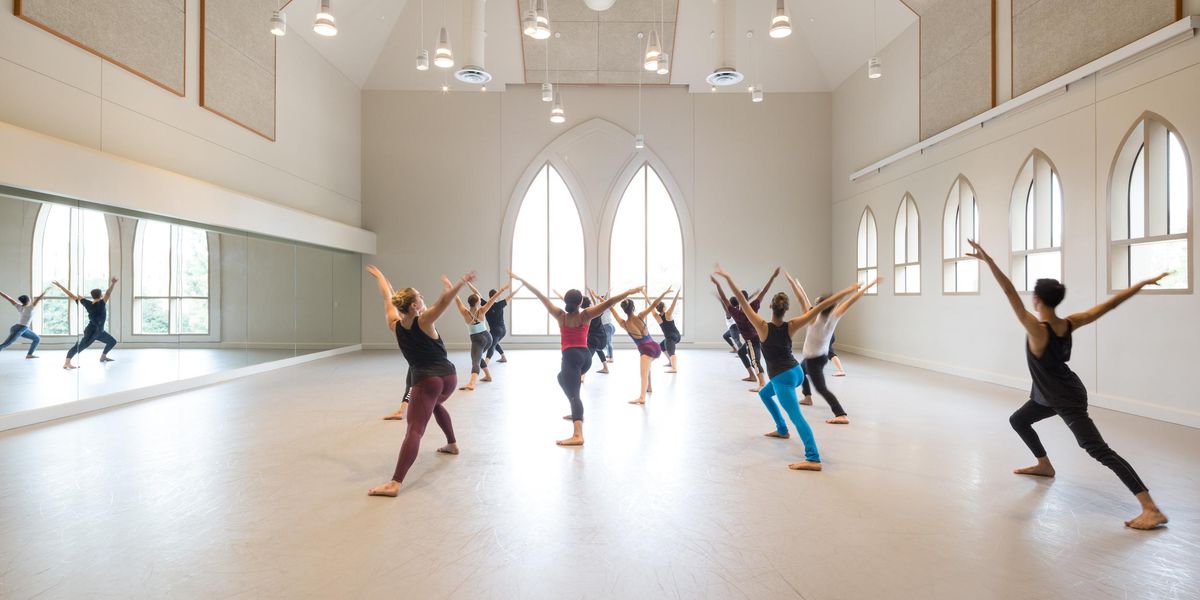Learning Curves: College Dance Companies
Storme Sundberg and Jason Ohlberg in UW’s Chamber Dance Company. Photo by Steve Korn, Courtesy UW Dance.
Marcus McCray was a rising junior at New World School of the Arts when he performed in New York City last June. Though he had only been studying dance for four years, he was a member of New World Dance Ensemble and gave an eye-catching performance in a mixed bill of Darshan Singh Bhuller’s work at the Ailey Citigroup Theater. The result? He was invited to take company class with the dancers of Ailey II for two weeks during his summer break. “Dancing for Darshan was one of the most pivotal moments of my college career,” McCray says. “He was an amazing instructor and coach who pulled out the highest quality from the dancers.”
While many schools offer stage time, the scope of performance opportunities varies from one institution to another. Some schools, like NWSA, even have separate dance companies to give talented students extra stage experience, touring opportunities and, in certain cases, extra credit. Of course, not every undergraduate is selected. But for those dancers who are able to handle the load—extra rehearsals on top of an already busy schedule—university ensembles can open unexpected and exciting doors.
Real Life Experience
At SUNY Purchase College Conservatory of Dance, students must audition for the Purchase Dance Company, which presents The Nutcracker each December and a mixed repertory program in the spring. Though they’re university productions, not all students are invited to perform; casting for each program is based on technical competency. “Students earn their place in the company,” says director Wallie Wolfgruber. The number of students in each production depends on the work, but it’s rare that all 135 dance majors are cast.
Hannah Wiley’s Chamber Dance Company at University of Washington is even more selective. Though the company is composed of MFA students—all of whom have performed in companies such as Limón Dance Company and Hubbard Street Dance Chicago—Wiley occasionally handpicks a few undergrads to augment the performances. She chose less than 10 for this past fall’s program. The stakes are high, but the experience working with such established artists gives undergrads an idea of professional life, not to mention valuable networking opportunities. A few UW alumni have built on their CDC experience and gone on to dance with Doug Varone and MOMIX.
Like professional companies, some college troupes tour. Mary Lisa Burns, dean of dance at NWSA, has made touring a primary element of her company, aiming to bring the New World Dance Ensemble to New York City each year. Purchase Dance Company presented its first New York City season last May with four nights at New York Live Arts. “To perform works in one of New York City’s most recognized performance venues was a great opportunity for our dancers to be seen by members of a larger New York audience,” says Wolfgruber. “It means exposure—opening doors to connect with people the students might not meet if we never left campus.”
Wolfgruber notes that the international tours are most eye-opening. “For some students, the trip to Taipei in 2011 was the first time out of the U.S. and the first time they were exposed to a culture different from their own,” she says. “It not only broadened their view of the dance world, but the world at large.”
Both Wolfgruber and Burns are quick to point out that their students’ main priority should be their school commitments. Neither Purchase Dance Company nor New World Dance Ensemble holds their tours until the summer. “The ensemble doesn’t rehearse during the regular school year, which meant some of our students who needed to take summer classes weren’t able to participate in the trip to New York,” says Burns. Company members also need to be quick learners—and not all higher ed students are ready to master demanding choreography in such time constraints. For example, Purchase students had one week to prepare for the NYLA program and less than two weeks before their trip to Taipei.
Extra Perks
In a job market that can be challenging, some college dance companies offer a little cushion. Burns, for instance, opened the ensemble to seven recent graduates, all of whom were paid a stipend for the performances in New York City and had their travel expenses covered by the school.
Wiley also hires alumni to perform with the company or learn roles as understudies. “When I need extra dancers, I’ll ask those who performed with CDC when they were undergrads,” says Wiley. “They know the company’s etiquette, and it’s a great stepping stone to more professional work.” Hired dancers receive a range of fees (depending on how many pieces they’re in) from $500 to $1,000; students receive college credit.
But even if a dancer isn’t chosen for a company spot, many college programs that have student companies also offer substantial stage opportunities for their core dance students. Purchase, for example, uses its proximity to New York City to its advantage by bringing in local choreographers, giving all of its dance majors the chance to work with contemporary artists like Kyle Abraham, Andrea Miller and Stephen Petronio. Additionally, all NWSA students perform throughout the school year in student, faculty and guest choreographers’ work, and dance majors at UW can perform in undergraduate concerts as well as MFA students’ concerts of original work.
And while a college company is certainly a brass ring worth reaching for, Wiley says that in some cases, “they can help some students discover that the rigor of professional dancing is not for them.” They can also—as Marcus McCray discovered from his New York trip—help to shed light on a professional performance career previously unimagined. Either way, students get a taste of what may lie ahead.
Leslie Holleran is a writer in Seattle, Washington.




